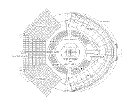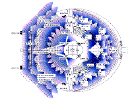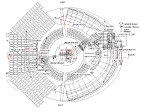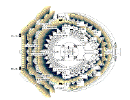The 18th Winter Olympic Games in Nagano
Audio Design for the Opening and Closing Ceremonies
 |
Reported by: |
Tetsuyuki Matsuki |
SOUND DESIGNER |
| Yasuo Aoki | SYSTEM DESIGNER | ||
| Kouji Moritani | SIM ENGINNER | ||
| Translated by: Fuji Kubota |
PREFACE
-
In the Autumn of 1996, the Opening and Closing ceremonies sound team finally finished its preparations for the 18th Olympic Winter Games in Nagano, although the other event teams had organized much earlier.
Because of its distinctive task, the sound team was composed of several companies, with one company leading the basic sound project. The six principal members of this joint team planned the first project in ten days, drawing on the experiences of the sound teams of the Opening and Closing Ceremonies for the Olympic Games in Lillehammer in Norway, the summer Olympic Games in Atlanta in the U.S., and its last five years of experience with the National Athletic Meet in Japan.
The first plan was designed as follows, taking into consideration the relative ratios of stage and the stands, entertainment and announcement, and the various weather conditions:
| 1. | An independent PA system, which transmitted clear and even announcements throughout the stadium. | ||
| 2. | A very small, but high powered PA system located at the center stage corners, capable of transmitting the full excitement of Beethoven's Symphony No.9 'Choral', and a Japanese Taiko drum performance, without creating dead angles. | ||
| 3. | Minimized digital delay, matrix setup to secure a synchronized audio-visual image of the audience close-up reflex and the sound. |
SOUND TEAM SCHEDULE
1997 December 13th and 14th The simulation for the closing ceremony December 21st and 22nd The simulation for the opening ceremony 1998 January 11th Construction for the multi-cable system and speaker poles started. 16th to 20th Sound Equipment had carried in to the stadium, and settings had started. January 21st to 22nd Speaker Modulation and Sound Field Modulation had conducted. January 23rd to February 5th The Rehearsal for the opening ceremony had started. February 6th The Run-through for the opening ceremony had conducted. February 7th The Opening Ceremony February 10th to 20th The rehearsals for the closing ceremony had been conducted. February 21st The run-through for the closing ceremony. February 22nd The closing ceremony. February 23rd to 25th Withdraw all the equipments from the stadium.
SR Plan
Needless to say, it was important to hold several press conferences (international broadcasting =ORTO) before agreeing upon SR.
The plan provided for the needs of the ceremony producers, musicians and art directors by supplying the correct speaker disposition, volume and timbre, thereby creating the desired atmosphere for the Olympic Ceremonies.
According to Mr. Seikun Kikutake's stadium spatial plan, there were 50,000 spectator seats, and 6,300 tiered arena seats for the athletic participants. 
The performance area included a 20 square meter center stage. The royal seats and VIP stage were located in the infield stands, and on the temporary outfield, 2,000 chorus seats were arranged in a row, along with a flame-holder that was positioned on the upper seat .
The ceremony producer, Mr. Keita Asari, asked the sound team to portray the unique solemnity of the Japanese during the ceremonies by producing a live broadcast with links in 5 different locations on each continent, in which Beethoven's symphony No.9 'Choral' would be performed simultaneously, via satellite.
The SR plan was implemented as follows;
Four main speakers were set up on the center stage, with both medium and small display speakers arranged to take sound projection and visibility from the audience into consideration. To create natural audio projection and visual images, the following pattern was programmed: for low-pitched sound, SR single circuit sub-woofer speakers were arranged below the rear arena seats to obtain an extra howling margin.
The center stage was 1.5m in height, and the distance between the center speaker to the rear spectator seat was 130m. There was not enough space to set a speaker tower on the center stage, as was done for the Opening and Closing Ceremonies at the Albertville Winter Olympic Games. In Albertville, a sound system tower was built on the stage center. Speakers were hung by wires, which were stretched around the spectator seats from the tower . This setup was not possible in the Nagano Olympic stadium.
Instead, small, narrowly directed (long-throw type) high power speakers were selected for the main sound system. The speakers were capable of operating in the rain and in low temperatures. They were used for both live and playback music sources.
After a number of experiments, several sets of "Xf (150Hz~20kHz, 2way, long-throw)" from 'X array series' and "Xb (40Hz~150Hz)" speakers were selected for use in conjunction with a power amplifier to gain a lower ratio announcement.  MSL-10/MSL-3 series speakers were placed around the outer rim of the stadium, but because of their inappropriate size, these speakers were not selected for the main system. The main speaker system was composed of a sub-woofer, 650-R2, an ATL's MPU-12 as a volume device, and an ATL's ADU-24, used to control programmable delay.
MSL-10/MSL-3 series speakers were placed around the outer rim of the stadium, but because of their inappropriate size, these speakers were not selected for the main system. The main speaker system was composed of a sub-woofer, 650-R2, an ATL's MPU-12 as a volume device, and an ATL's ADU-24, used to control programmable delay.
Sets of UPA-1A were arranged in several places to assist in producing the intended effect of the main speakers, which were placed at four different locations.
- Delay Speakers



Bose 502A and 502B speakers were divided into three systems, and twenty-two sets were placed in the front row of the infield stands.
On the second floor of the infield stands, twenty-one sets of three systemic JF80 were arranged. UPA-1A and 650-R2 were were combined in two different systems, and twelve sets were placed in the front row of the outfield stands. 502A speakers were distributed over both the second and third floors of the outfield stands, with twelve to fourteen speakers on each floor.
The 502A speaker exhibits a flat frequency response that covers wide spaces. It can also be easily be installed at the tops of poles. For protection from rain and snow, special covers were designed for these speakers. To attain clear audibility of announcements made over background music playing through the main speakers, matrix and delay were modulated. This adjustment made the sound isometrical from every seat in the stadium.
- Monitor Speakers

 Two sets of UPA-1A and 650-R2 speakers were set up to the left and right of the VIP seats, and two sets of five S-1202 speakers were placed in the right and left dugouts during the fanfare band performance. The fanfare speakers had a 360゜range of projection, and were primarily used during the closing ceremony. The fanfare monitor speakers were also used as the fundamental tone silhouette target speakers, and were used to project the sound of the wooden clappers usually heard at Sumo matches (traditional Japanese wrestling). These speakers were positioned at point zero in direct sound, and were utilized at the very beginning of the Opening Ceremony.
Two sets of UPA-1A and 650-R2 speakers were set up to the left and right of the VIP seats, and two sets of five S-1202 speakers were placed in the right and left dugouts during the fanfare band performance. The fanfare speakers had a 360゜range of projection, and were primarily used during the closing ceremony. The fanfare monitor speakers were also used as the fundamental tone silhouette target speakers, and were used to project the sound of the wooden clappers usually heard at Sumo matches (traditional Japanese wrestling). These speakers were positioned at point zero in direct sound, and were utilized at the very beginning of the Opening Ceremony.
Several monitor speakers were arranged at the four cardinal points of both the inside and outside gates of the flame-holder control room during the ceremonial procession to give performers and Olympic staff the cue to begin the program. A small, single circuit speaker was readied for use in case of emergency during the final stages of the lighting of the sacred-fire. Fortunately, there was no need for the emergency system during the ceremony.
Several trumpet, and other, speakers, which were already in place outside the stadium, were used to produce a ceremonial atmosphere befitting the Olympics.
- Effect Speakers

 MSL-10's were used to create an effect speaker system, and were arranged in two sections, on the upper rim of the southerly outfield. This section was very windy and cold, and the mean temperature was sub-zero. Even the snow on the Saran-net was frozen hard. However, the MSL-10 is very powerful and has been manufactured for outside use. It has both a heating system and a rainwater discharger. From this system, the music of the fanfare band, which was stationed under the Olympic sacred-fire, the peal of the Zenkoji temple bell, and sound from the giant screen, were transmitted to the audience. To support the system, the front left and right X-array transmitted delay in conjunction with the MSL-10's.
MSL-10's were used to create an effect speaker system, and were arranged in two sections, on the upper rim of the southerly outfield. This section was very windy and cold, and the mean temperature was sub-zero. Even the snow on the Saran-net was frozen hard. However, the MSL-10 is very powerful and has been manufactured for outside use. It has both a heating system and a rainwater discharger. From this system, the music of the fanfare band, which was stationed under the Olympic sacred-fire, the peal of the Zenkoji temple bell, and sound from the giant screen, were transmitted to the audience. To support the system, the front left and right X-array transmitted delay in conjunction with the MSL-10's.
Two sets of six MSL-3's were placed between the infield and outfield stands on both the east and west upper rims of the stadium to modulate sound ambience and the surround-sound system. Each reverberation was calculated, and delay time was adjusted for each reverberation.
SR Pattern Because the Opening and Closing Ceremonies utilized several stages simultaneously, the speaker system distribution needed to be composed of more than sixteen matrices. The matrices were used to modulate microphones positioned among the spectator seats, via the power amplifier. Given the situation, it was preferable to sort the mixing groups into sixteen systems, according to the differing positions of the fundamental tone and the type of input source (announcement or entertainment), before distributing the speaker systems. Since June of 1997, the sound team had been looking for a particular kind of digitally controlled matrix console that was world renowned for its reliability and satisfactory results. The team needed a digitally controlled matrix console capable of changing group-to-mix levels and delay value flexibly.  In October 1997, LD-88s (8×8) was finally procured after much deliberation. This matrix console has been widely used in Broadway musicals and Las Vegas shows, and has MIDI control function. At this time, the following control patterns were operated by LD-88s: stopping and starting a number of MD, CD, and DAT, System EQ (CP-10), volume control (MPU-12), and digital delay (ADU-24).
In October 1997, LD-88s (8×8) was finally procured after much deliberation. This matrix console has been widely used in Broadway musicals and Las Vegas shows, and has MIDI control function. At this time, the following control patterns were operated by LD-88s: stopping and starting a number of MD, CD, and DAT, System EQ (CP-10), volume control (MPU-12), and digital delay (ADU-24).
- Entertainment
The central source level setting for both front and rear left /right speakers on the center stage were exercised in the following order: outfield UPA-1A, VIP UPA-1A, sub-woofer, and 502A. The volume of fff (fortississimo) was checked against a 10dB level margin, which was based on a capacity audience, and took into consideration the console matrix balance. |
The center stage front left/right speakers were inputted, and the rear left/right speakers were outputted (initially, this sound pattern was chosen for a choral practice when the athletic participator seats were empty, and then confirmed considering that a time lag might be caused by audience participation if both of rear speakers were inputted). Both the infield and outfield front row speakers were selected for the main system, and the PA system was set to time zero. The second and third rows 502A level and time were tuned to the main system. The chorus microphones PA system for the infield were set at 100%, the front side of the chorus line's UPA-1A on the outfield stand were cut off, the outside of the outfield stands UPA-1A speakers were at 60%, and the outfield 502A speakers were at 80%, and 100% from the center stage side fill. Consequently, the SR system projected a sound perfect for an audience of 50,000 people. |

Since this was an actual performance, the athletic participants were already seated, so the speaker system for the center stage rear (south) side was lowered to 50% to adjust the sound volume so it wouldn't reach the outfield stands. The PA system for the actual performance in the southern half of the stadium was based on the chorus practice pattern indicated in 2, and the northern half of the stadium followed the basic pattern indicated in 1. A slight time lag occurred, but because it created a seemingly magical surround-sound effect, it was a great success. |

The PA pattern for the fanfare band during the closing ceremony was the complete opposite of the PA pattern used for Symphony No.9. The band performed the national anthem and fanfare from both sides of the north stage. To set up a time-zero point at the fanfare band position, the target speakers were arranged in order to extend the sound image, and the delay speakers on the infield stand were inputted to support the target speakers. |
- Announcement
The groups were composed as follows; 'center・stage・microphone・ pattern,' 'announcement・booth・pattern,' 'north・stage・microphone pattern'; the matrix most advantageous to the howling margin was assembled. The center stage was set as a basic zero position for delay time.
From Simulation to Actual Performance
- February 7th: The Opening Ceremony
A simulation of the Opening and Closing Ceremonies was conducted in December of 1997. After the simulation, several problems were brought to the attention of the sound team by the producers, directors and performers, in order to insure a successful performance. Because of the limited budget and preparation period, it was impossible to reconstruct the whole project. Therefore, meetings with the music adviser, Seiji Ozawa, were very important at that time. It was essential to confirm the sound volume, tone scale, and acoustic differences in the theater and outdoor stadium with Mr. Ozawa. The final plan was drawn up after having several discussions about the ideal sound field and various problems in the simulation system.
Mr. Ozawa asked the team to create an ambience of sound that filled the stadium, and to raise its pitch. To fulfill these requests, twenty sub-woofers (650-R2) were added to the near infield and outfield stands. Finally, the year of the Olympic games began, and the speaker pole construction and multicable and electric wiring started on January 11th. The center stage was wired by wiring specialists. The lead wire in the wire duct buried under the field already lead to the center stage. The speaker poles were secured to the spectator seat railings .  On January 16th, the audio equipment was brought into the stadium. Since it was the day after a very heavy snowfall, clearing the snow on the road to the stadium took a long time. Unfortunately, the delivery of some of the equipment was delayed by the storm, but a part time worker from Nagano bulldozed the snow and retrieved the equipment. On January 21st, the sound began to modulate the sound field using two SIM machines. The SIM engineers, Koji Moritani and Shoji Yuzawa, tuned the timbre for each speaker and set up the delay between systems, for use in the noisy stadium. Because the team had to work in the dark after 5 p.m., everyone hastened to finish their daily schedule. In winter time, sunlight hours are short, and the temperature drops suddenly after sunset, so it is necessary to plan daily schedules from 8 a.m. to 4 p.m. Also, given the frequently harsh weather in winter, it is advisable to have a cushion of spare time for outdoor projects. On January 23rd, rehearsal finally got underway. The rehearsal for each section was conducted mainly on weekends and holidays, until the run-through on February 6th, when the sound field for each performances was set. I had to travel between Nagano to Tokyo 5 times a day by a car, because the music recording was still unfinished, I was stressed out from the hard work and from working in a team. Mr. Haruhiko Oono, who was in charge of music recording, already understood the speaker system since he had participated in the simulation and heard the playback. For this reason, there were no misunderstandings between the PA and music recording teams, even though we had to work through several nights at the NHK and SOUNDIN studios. It was essential to include the music production and field work teams in the PA staff preparations for an event run on a tight schedule for the following reasons: When the field team distributed the sound sources into DAT, CD and Multi DAT, the music producers needed to adjust the sampling frequencies. Also, the producers needed to work with the field team to make formal tapes and confirm the sync hronization of various pieces of back-up equipment. Were the production team to have worked alone, they would never have gotten a moments rest. In addition, if they had been unable to work with the field team, their formal tapes would have lacked harmony. On February 6th, The Satellite circuit run-through began. The run-through was conducted under the same conditions predicted for the actual performance, with a volunteer audience. The images and sound of Beethoven's Symphony No.9 were condensed and cabled out from Nagano to New York, Beijing, Sydney, Berlin and Cape Town. Simultaneously, the images and sound of choirs in these distant cities, which were singing along with the satellite projection, came back to the circuit center located next to the stadium. A number of pictures and sound lines were sent directly to the circuit center via ISDN from Nagano Prefecture Cultural Center, where the symphony was performed. A delay matrix was inserted into every sound circuit originating at the performance site. The timing of the signals from each site was adjusted to the signal from Berlin, which was delayed by 2.1 seconds, and then distributed to the broadcasting and PA systems. The PA for this satellite system performance was created by 2 mixes from the Nagano Prefecture Cultural Center, 2 mixes from each of the Overseas Choirs, and four mixes from the stadium, where a chorus of 2,000 local singers was performing. The Satellite run-through of Symphony No.9 was a success, and the final preparations for the following day began .
On January 16th, the audio equipment was brought into the stadium. Since it was the day after a very heavy snowfall, clearing the snow on the road to the stadium took a long time. Unfortunately, the delivery of some of the equipment was delayed by the storm, but a part time worker from Nagano bulldozed the snow and retrieved the equipment. On January 21st, the sound began to modulate the sound field using two SIM machines. The SIM engineers, Koji Moritani and Shoji Yuzawa, tuned the timbre for each speaker and set up the delay between systems, for use in the noisy stadium. Because the team had to work in the dark after 5 p.m., everyone hastened to finish their daily schedule. In winter time, sunlight hours are short, and the temperature drops suddenly after sunset, so it is necessary to plan daily schedules from 8 a.m. to 4 p.m. Also, given the frequently harsh weather in winter, it is advisable to have a cushion of spare time for outdoor projects. On January 23rd, rehearsal finally got underway. The rehearsal for each section was conducted mainly on weekends and holidays, until the run-through on February 6th, when the sound field for each performances was set. I had to travel between Nagano to Tokyo 5 times a day by a car, because the music recording was still unfinished, I was stressed out from the hard work and from working in a team. Mr. Haruhiko Oono, who was in charge of music recording, already understood the speaker system since he had participated in the simulation and heard the playback. For this reason, there were no misunderstandings between the PA and music recording teams, even though we had to work through several nights at the NHK and SOUNDIN studios. It was essential to include the music production and field work teams in the PA staff preparations for an event run on a tight schedule for the following reasons: When the field team distributed the sound sources into DAT, CD and Multi DAT, the music producers needed to adjust the sampling frequencies. Also, the producers needed to work with the field team to make formal tapes and confirm the sync hronization of various pieces of back-up equipment. Were the production team to have worked alone, they would never have gotten a moments rest. In addition, if they had been unable to work with the field team, their formal tapes would have lacked harmony. On February 6th, The Satellite circuit run-through began. The run-through was conducted under the same conditions predicted for the actual performance, with a volunteer audience. The images and sound of Beethoven's Symphony No.9 were condensed and cabled out from Nagano to New York, Beijing, Sydney, Berlin and Cape Town. Simultaneously, the images and sound of choirs in these distant cities, which were singing along with the satellite projection, came back to the circuit center located next to the stadium. A number of pictures and sound lines were sent directly to the circuit center via ISDN from Nagano Prefecture Cultural Center, where the symphony was performed. A delay matrix was inserted into every sound circuit originating at the performance site. The timing of the signals from each site was adjusted to the signal from Berlin, which was delayed by 2.1 seconds, and then distributed to the broadcasting and PA systems. The PA for this satellite system performance was created by 2 mixes from the Nagano Prefecture Cultural Center, 2 mixes from each of the Overseas Choirs, and four mixes from the stadium, where a chorus of 2,000 local singers was performing. The Satellite run-through of Symphony No.9 was a success, and the final preparations for the following day began .
| CONSOLE BLOCK DIAGRAM |
| PM-4000/40 |
| PM-4000/48 |
I was positioned beside the Royal box, near Mr. Asari, the producer. From there, I relayed stadium conditions and cues to the PA booth. Finally, after the countdown, the Opening Ceremony began at 11 a.m. The peal of the Zenkoji Temple bell, which was cabled in by ISDN, was projected by MSL-10 on both the left and right sides of the flame-holder.



 The total sound field and delay transaction were controlled by a matrix of PM-4000 and LD-88s. An original auto-cue system called "Kikkakekun"and LD-88s controlled two DATs and a DA-98 (multiple 8ch). The Opening Ceremony procession took longer than we had expected, but fortunately, we had prepared extra music in case of emergencies during the ceremony. The flame was lit by the final torch bearer while Madam Butterfly was projected by the speakers (Madam Butterfly had been recorded the night before by The Winter Orchestra) .
The total sound field and delay transaction were controlled by a matrix of PM-4000 and LD-88s. An original auto-cue system called "Kikkakekun"and LD-88s controlled two DATs and a DA-98 (multiple 8ch). The Opening Ceremony procession took longer than we had expected, but fortunately, we had prepared extra music in case of emergencies during the ceremony. The flame was lit by the final torch bearer while Madam Butterfly was projected by the speakers (Madam Butterfly had been recorded the night before by The Winter Orchestra) .
Finally, Mr. Ozawa conducted Symphony No. 9. Via amazing auto-timing controlled technology, and at tremendous cost, the whole performance was televised worldwide using the satellite system. Audiences all over the world experienced the thrill of the performance by the "Northern Orchestra" accompanied by a choir 2,000 strong, held in Nagano stadium.
Conclusion
The ages of the members of the sound team ranged from 20 to 60, however, the team worked together cooperatively. After the Olympic Games, the engineering team commented that it had been a great opportunity to work the event with the media team. The younger staff members were excited to be able to prevent errors, by running around the stadium with equipment during the ceremonies.
At first, I personally felt a lot of pressure from taking part in one of the most salient events of the century. However, my fear turned into excitement during the course of the project because of the wonderful team work. In conclusion, I'd like to express my appreciation for every one of the members of my staff who tried very hard, and for the opportunity to participate in this memorable event.
EQUIPMENT LIST
TRANSDUCERS MICROPHONEAKGC-451 12
SONYC-74 4
SANKENCU-32 24
SHURESM-57 22
SM-58 12
SENNHEISERMD-421 10 DICOUNTRY MANTYPE-85 10 PLAY BACK CDSTUDER
2
DENONDN-951 5 MDSONYMDS-E3 3 DATSONYDTC-A8 2
SONY
3 8CH DATTASCAMDA-98 2 MIXING CONSOLE
YAMAHAPM-4000 2
PM-4000M 1
O2R 1
ATL2408MS 1
MACKIE DESIGNSCR-1604 3
LEVEL CONTOROL SYSTEMSLD-88 2 EQUALIZERS
MEYERCP-10 20
ATLDCP-10 4
SONYMU-E311 12
EFFECTORS DELAY LINEATLADU-24 10 COMPRESSORdbxdbx160 4
166 4
BSSDPR-502 2 EFFECTYAMAHASPX-900 2
REV-5 2
LEXICONPCM-70 2 AMPLIFIERS
YAMAHAPC1002
PC2002
PC3500
PC7500
MEYERMS1000
QSCPOWER LIGHT4.0
LOUDSPEAKERS
MEYERMSL-10 4
MSL-3 12
UPA1-A 32
USM 2
650R-2 24
ELECTRO VOICEXf 16
Xb 16
S-1202 12
FM-1202 2
S-200 4
BOSE502A 50
502B 16
101 6
EAWJF-80 26
SONYMU-333W 16
HOME | UPDATE | PRICE | FIELD NEWS
SHOWBIZ LINK | COMPANY | STAFF | HISTORY


